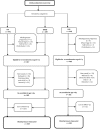Maternal-Infant Supplementation with Small-Quantity Lipid-Based Nutrient Supplements Does Not Affect Child Blood Pressure at 4-6 Y in Ghana: Follow-up of a Randomized Trial
- PMID: 30753625
- PMCID: PMC6398380
- DOI: 10.1093/jn/nxy285
Maternal-Infant Supplementation with Small-Quantity Lipid-Based Nutrient Supplements Does Not Affect Child Blood Pressure at 4-6 Y in Ghana: Follow-up of a Randomized Trial
Abstract
Background: In the International Lipid-Based Nutrient Supplements (iLiNS)-DYAD-Ghana trial, prenatal small-quantity lipid-based nutrient supplements (LNSs) had a positive effect on birth weight. Birth weight may be inversely related to blood pressure (BP) later in life.
Objectives: We examined the effect of the intervention on BP at 4-6 y of age, and maternal and child factors related to BP.
Methods: The iLiNS-DYAD-Ghana study was a partially double-blind, randomized controlled trial which assigned women (n = 1320) ≤20 weeks of gestation to daily supplementation with: 1) iron and folic acid during pregnancy and 200 mg Ca for 6 mo postpartum , 2) multiple micronutrients during pregnancy and postpartum, or 3) LNSs during pregnancy and postpartum plus LNSs for infants from 6 to 18 mo of age. At 4-6 y of age (n = 858, 70% of live births), we compared BP, a secondary outcome, between non-LNS and LNS groups and examined whether BP was related to several factors including maternal BP, child weight-for-age z score (WAZ), and physical activity.
Results: Non-LNS and LNS groups did not differ in systolic (99.2 ± 0.4 compared with 98.5 ± 0.6 mm Hg; P = 0.317) or diastolic (60.1 ± 0.3 compared with 60.0 ± 0.4 mm Hg; P = 0.805) BP, or prevalence of high BP (systolic or diastolic BP ≥90th percentile of the US National Heart, Lung, and Blood Institute reference: 31% compared with 28%; P = 0.251). BP at 4-6 y of age was positively related to birth weight; this relation was largely mediated through concurrent WAZ in a path model. Concurrent WAZ and maternal BP were the factors most strongly related to child BP.
Conclusions: Despite greater birth weight in the LNS group, there was no intervention group difference in BP at 4-6 y. In this preschool population at high risk of adult hypertension based on BP at 4-6 y, high maternal BP and child WAZ were key factors related to BP. This trial was registered at clinicaltrials.gov as NCT00970866.
Keywords: Ghanaian children; prenatal; infant nutrition; blood pressure; lipid-based nutrient supplements; supplementation.
© 2019 American Society for Nutrition.
Figures




References
-
- Adair LS, Kuzawa CW, Borja J. Maternal energy stores and diet composition during pregnancy program adolescent blood pressure. Circulation. 2001;104(9):1034–9. - PubMed
-
- Huxley RR, Shiell AW, Law CM. The role of size at birth and postnatal catch-up growth in determining systolic blood pressure: a systematic review of the literature. J Hypertens. 2000;18(7):815–31. - PubMed
-
- Adair L, Dahly D. Developmental determinants of blood pressure in adults. Annu Rev Nutr. 2005;25:407–34. - PubMed

